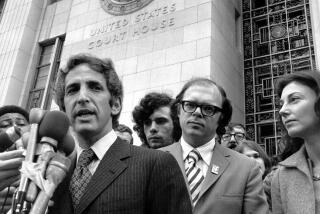Rose Mary Woods, 87; Nixon Aide Famous for Tape Erasure
- Share via
WASHINGTON — Rose Mary Woods, President Nixon’s loyal secretary who took initial responsibility for erasing part of a key White House audiotape during the Watergate investigation, has died. She was 87.
Woods died Saturday night at a nursing home in Alliance, Ohio, about 60 miles south of Cleveland. The cause of death was not reported.
A photo of Woods showing how the erasure could have occurred -- stretching backward to answer the phone with her left hand while inadvertently hitting the “record” button and keeping her right foot on the tape recorder’s pedal -- became a searing image of the scandal.
Woods worked for Nixon for nearly 25 years, joining his staff after the young Republican was elected to the Senate from California in 1950. She remained with him during his years as Dwight Eisenhower’s vice president and through his unsuccessful 1960 presidential campaign, followed him to private law practice in New York, then returned with him to Washington when he won the White House in 1968. Ironically, at the time of the scandal, she lived in the Watergate complex, not far from the Democratic National Committee offices that GOP operatives had hoped to bug.
After Nixon resigned the presidency in August 1974, Woods remained in Washington for several years and eventually returned to her native Ohio. During her service to Nixon, as personal secretary and in a much broader way as one of his closest gatekeepers, Woods was always held dear by the president.
Indeed, Nixon asked Woods to tell his wife and two daughters that he had decided to resign, and she stood with them Aug. 9, 1974, as he boarded a helicopter on the South Lawn of the White House and became the first chief executive in U.S. history to step down.
“Rose,” Nixon said once, “is as close to us as family.”
Nixon’s daughters, Julie Nixon Eisenhower and Tricia Nixon Cox, said Sunday in a statement that Woods “was a cherished friend to us and to all who knew her.”
“None of us,” they said, “will forget how she served her country with unswerving loyalty and dedication throughout her entire career.”
Woods will forever be remembered by the American public for the demonstration photo taken at the height of the Watergate scandal of her reaching for the phone with her foot still on the recorder pedal. She said she was startled by the ringing telephone and “inadvertently” hit the record button, erasing some of the tape in what famously became known as the “18 1/2 -minute gap.”
The tape was from a June 20, 1972, conversation between Nixon and H.R. Haldeman, his chief of staff, that occurred just three days after burglars entered the Democratic headquarters in the Watergate complex. Because of the timing of the conversation, investigators both on Capitol Hill and in the special prosecutor’s office believed it could have answered the question, made famous during congressional hearings, about what Nixon knew about the break-in and when he knew it.
Today, three decades later, it is still not known whether the erasure was accidental or on purpose, and experts at the National Archives have all but given up trying to enhance the recording and restore the lost conversation. It remains one of the great mysteries of that time -- why Woods hit the record button and lost into the ether what she was supposed to be transcribing. The White House at first tried to rest all of the blame on Woods, but also backed her up in insisting it was inadvertent because she had been busy for weeks transcribing volumes of tapes that had been subpoenaed.
“I know I did not do it,” Nixon said of the erasure. “And I completely believe Rose when she says that she did not do it.”
In 1974, John J. Sirica, the federal judge who heard the Watergate criminal trials, appointed a panel of experts to investigate how the gap occurred. They reported back that they found evidence of at least five -- and perhaps as many as nine -- erasures.
Woods at first said she “must have” done it. But in later years, while rarely surfacing in public and even less frequently discussing the scandal, she sometimes sought to avoid responsibility. At an event commemorating the 25th anniversary of the break-in, she said the tape gap -- along with those who lived through the Watergate scandal -- was slowly fading into history. “Every once in a while I get notes and things from some of the people who were with us, but not much,” she said. “Everybody gets sort of separated.”
Woods was born in Sebring, Ohio, the granddaughter of an Irish immigrant who made it to America as a shipboard stowaway. She began her secretarial career in Sebring and moved to Washington as a Capitol Hill typist.
Soon she was working for Nixon in his Senate office and, ultimately, in the White House.
In the years after his resignation, Nixon sometimes talked of Woods as much more than just a secretary. He said the two of them were the only ones in the White House who knew that Atty. Gen. John Mitchell, another disgraced Watergate figure, had to send his wife “away” because she was emotionally distraught.
And on a political note, Nixon recalled how Woods could be fiercely loyal in favoring the president’s party over the Democrats. She made up the invitation lists for White House lunches and dinners, and Nixon remembered how she once “went out of her mind” when he requested that Hubert Humphrey -- Nixon’s Democratic opponent in the 1968 election -- be included at an event.
Woods never married, and no immediate survivors were known.
More to Read
Sign up for Essential California
The most important California stories and recommendations in your inbox every morning.
You may occasionally receive promotional content from the Los Angeles Times.











